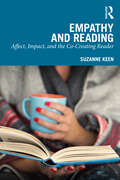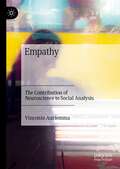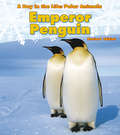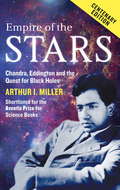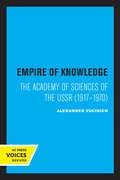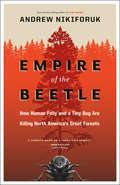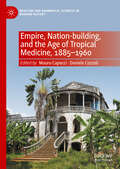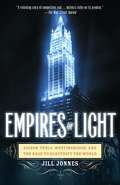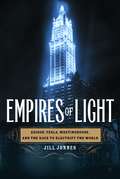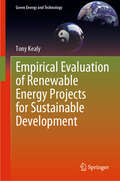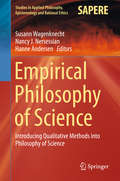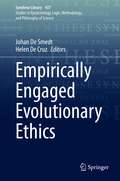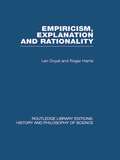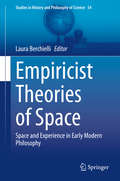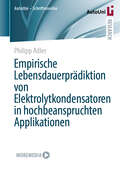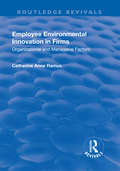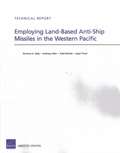- Table View
- List View
Empathy and Reading: Affect, Impact, and the Co-Creating Reader
by Suzanne KeenThis pioneering collection brings together Suzanne Keen’s extensive body of work on empathy and reading, charting the development of narrative empathy as an area of inquiry in its own right and extending cross-disciplinary conversations about empathy evoked by reading. The volume offers a brief overview of the trajectory of research following the 2007 publication of Empathy and the Novel, with empathy understood as a suite of related phenomena as stimulated by representations in narratives. The book is organized around three thematic sections—theories; empathetic readers; and interdisciplinary applications—each preceded by a short framing essay. The volume features excerpts from the author’s seminal works on narrative empathy and makes available her harder-to-access contributions. The book brings different strands of the author’s research into conversation with existing debates, with the aim of inspiring future interdisciplinary research on narrative empathy. This book will be of interest to students and scholars in such fields as literary studies, cognitive science, emotion studies, affect studies, and applied contexts where empathetic practitioners work.
Empathy and Reading: Affect, Impact, and the Co-Creating Reader
by Suzanne KeenThis pioneering collection brings together Suzanne Keen’s extensive body of work on empathy and reading, charting the development of narrative empathy as an area of inquiry in its own right and extending cross-disciplinary conversations about empathy evoked by reading. The volume offers a brief overview of the trajectory of research following the 2007 publication of Empathy and the Novel, with empathy understood as a suite of related phenomena as stimulated by representations in narratives. The book is organized around three thematic sections—theories; empathetic readers; and interdisciplinary applications—each preceded by a short framing essay. The volume features excerpts from the author’s seminal works on narrative empathy and makes available her harder-to-access contributions. The book brings different strands of the author’s research into conversation with existing debates, with the aim of inspiring future interdisciplinary research on narrative empathy. This book will be of interest to students and scholars in such fields as literary studies, cognitive science, emotion studies, affect studies, and applied contexts where empathetic practitioners work.
Empathy: The Contribution of Neuroscience to Social Analysis
by Vincenzo AuriemmaThis book examines the concept of empathy in sociological and neuroscientific discourses using innovative perspectives from sociology and social neuroscience. Through a transdisciplinary approach, the author delves into the history of empathy and its social, cultural and semantic changes, and then reviews the conception of empathy in neuroscientific discourse.Distancing itself from the traditional neuroscientific literature of biological universalism, this volume offers an innovative perspective on empathy. It also opens a new avenue for neurosociology, which is presented as the discipline that can emphasize all the cultural and emotional aspects that govern empathy. Key themes addressed in the text are: empathy in all its meanings, from Hume to TenHouten; neurosociology as one possible avenue for embracing the cultural and neuroscientific aspects of empathy; and empirical research. A valuable resource for sociology students and academics in the field of empathy and neurosociology, this book is also of interest to those studying sociological thought, and social neuroscience.
Emperor Penguin (A Day in the Life: Polar Animals)
by Katie MarsicoFrom sun up to sundown, this nonfiction book takes young nature explorers and zoologists through a day in the life of the emperor penguin. Discover their Antarctic home, eating habits, and fascinating behaviors. Plus, kids can continue exploring after the penguins go to sleep! A step-by-step life cycle diagram, critical-thinking questions, and further resources will keep fact-hungry kids learning about the emperor penguin.
Emperors of the Deep: Sharks—The Ocean's Most Mysterious, Most Misunderstood, and Most Important Guardians
by William McKeeverWhat we can learn from sharks—evolutionary marvels that have survived for 450 million years, and are essential to our planet’s ecosystem.We’re conditioned to see sharks as terrifying, cold-blooded underwater predators. But as Ocean Guardian founder William McKeever reveals, we need to ensure that their remarkable longevity continues. The first book to reveal in full the hidden lives of sharks, Emperors of the Deep focuses on four species—Mako, Tiger, Hammerhead, and Great White—as never before, including such fascinating details as:Sharks are 50 million years older than treesSharks have survived five extinction level events, including the one that killed off the dinosaursSharks have electroreception, a sixth sense that lets them pick up on electric fields generated by living thingsSharks can dive 4,000 feet below the surfaceSharks account for only six human fatalities per year, while humans kill 100 million sharks per yearMcKeever goes back through time to probe the shark’s prehistoric secrets and how it has become the world’s most feared, and most misunderstood, predator, and takes us on a pulse-pounding tour around the world and deep under the surface, from the frigid waters of the Arctic Circle to the coral reefs of the tropical Central Pacific. He also interviews ecologists, conservationists, and world-renowned shark experts, including the founders of Greenpeace’s Rainbow Warrior, the head of the Massachusetts Shark Research Program, and the self-professed “last great shark hunter.”At once a deep dive into the misunderstood world of sharks and an urgent call to protect them, Emperors of the Deep celebrates this wild species that hold the key to unlocking the mysteries of the ocean—if we can prevent their extinction from climate change and human hunters.“Many astonishing facts.” —The Guardian“[An] extraordinary book [that] rarely fails to inform and delight.” —The Washington TimesIncludes photographs
Empire Of The Stars: Friendship, Obsession and Betrayal in the Quest for Black Holes
by Arthur I. MillerIn August 1930, on a boat trip from Bombay to England, the young Indian scientist Subrahmanyan Chandrasekhar calculated that certain stars could end their lives by collapsing indefinitely to a point - to nowhere. This idea brought Chandra into conflict with Sir Arthur Eddington, the grand old man of British astrophysics, who publicly ridiculed the idea.EMPIRE OF THE STARS teases out the major implications of this infamous event, setting it against the backdrop of the turbulent growth of astrophysics, and provides a unique window on our unfolding view of the cosmos. In its clash of personalities, epochs and cultures, the story reveals the deep-seated psychological and philosophical prejudices at work in the acceptance and rejection of new scientific ideas.Beautifully written, artfully constructed, EMPIRE OF THE STARS is a serious book but one which also deals with classic themes -- a lone man struggling against the establishment, intellectual rivalry and the highs and lows of great individuals set against the broader sweep of history.
Empire Of The Stars: Friendship, Obsession and Betrayal in the Quest for Black Holes
by Arthur I. MillerIn August 1930, on a boat trip from Bombay to England, the young Indian scientist Subrahmanyan Chandrasekhar calculated that certain stars could end their lives by collapsing indefinitely to a point - to nowhere. This idea brought Chandra into conflict with Sir Arthur Eddington, the grand old man of British astrophysics, who publicly ridiculed the idea.EMPIRE OF THE STARS teases out the major implications of this infamous event, setting it against the backdrop of the turbulent growth of astrophysics, and provides a unique window on our unfolding view of the cosmos. In its clash of personalities, epochs and cultures, the story reveals the deep-seated psychological and philosophical prejudices at work in the acceptance and rejection of new scientific ideas.Beautifully written, artfully constructed, EMPIRE OF THE STARS is a serious book but one which also deals with classic themes -- a lone man struggling against the establishment, intellectual rivalry and the highs and lows of great individuals set against the broader sweep of history.
Empire and Science in the Making
by Peter BoomgaardDrawing on extensive new research, and bringing much new scholarship before English readers for the first time, this wide-ranging volume examines how knowledge was created and circulated throughout the Dutch Empire, and how these processes compared with those of the Imperial Britain, Spain, and Russia.
Empire of Knowledge: The Academy of Sciences of the USSR 1917 - 1970
by Alexander VucinichThis title is part of UC Press's Voices Revived program, which commemorates University of California Press’s mission to seek out and cultivate the brightest minds and give them voice, reach, and impact. Drawing on a backlist dating to 1893, Voices Revived makes high-quality, peer-reviewed scholarship accessible once again using print-on-demand technology. This title was originally published in 1984.
Empire of the Air
by Jenifer Van VleckJenifer Van Vleck's fascinating history reveals the central role commercial aviation played in the United States' ascent to global preeminence in the twentieth century. As U. S. military and economic influence grew, the federal government partnered with the aviation industry to deliver American power across the globe and to sell the idea of the "American Century" to the public at home and abroad. The airplane promised to extend the frontiers of the United States "to infinity," as Pan American World Airways president Juan Trippe said. As it accelerated the global circulation of U. S. capital, consumer goods, technologies, weapons, popular culture, and expertise, few places remained distant from Wall Street and Washington. Aviation promised to secure a new type of empire--an empire of the air instead of the land, which emphasized access to markets rather than the conquest of territory and made the entire world America's sphere of influence. By the late 1960s, however, foreign airlines and governments were challenging America's control of global airways, and the domestic aviation industry hit turbulent times. Just as the history of commercial aviation helps to explain the ascendance of American power, its subsequent challenges reflect the limits and contradictions of the American Century.
Empire of the Air: The Men Who Made Radio
by Tom LewisEmpire of the Air is a history of radio in the United States. It tells the almost-unknown story of three American visionaries--scientist Lee de Forest, brilliant recluse Edwin H. Armstrong, and RCA mogul David Sarnoff--whose imagination and dreams turned a hobbyists' toy into radio, launching the modern communication age. It is a tale of pioneers on the frontier of a new technology, of American entrepreneurial spirit, and of the tragic collision between the lone inventor and the large corporation. Court cases would decide whose legacy would reign supreme. A magnificently researched biography of extraordinary men whose achievements changed our lives forever.
Empire of the Beetle
by Andrew NikiforukBeginning in the late 1980s, a series of improbable bark beetle outbreaks unsettled iconic forests and communities across western North America. An insect the size of a rice kernel eventually killed more than 30 billion pine and spruce trees from Alaska to New Mexico. Often appearing in masses larger than schools of killer whales, the beetles engineered one of the world's greatest forest die-offs since the deforestation of Europe by peasants between the eleventh and thirteenth centuries. The beetle didn't act alone. Misguided science, out-of-control logging, bad public policy, and a hundred years of fire suppression created a volatile geography that released the world's oldest forest manager from all natural constraints. Like most human empires, the beetles exploded wildly and then crashed, leaving in their wake grieving landowners, humbled scientists, hungry animals, and altered watersheds. Although climate change triggered this complex event, human arrogance assuredly set the table. With little warning, an ancient insect pointedly exposed the frailty of seemingly stable manmade landscapes.Drawing on first-hand accounts from entomologists, botanists, foresters, and rural residents, award-winning journalist Andrew Nikiforuk, investigates this unprecedented beetle plague, its startling implications, and the lessons it holds.
Empire, Nation-building, and the Age of Tropical Medicine, 1885–1960 (Medicine and Biomedical Sciences in Modern History)
by Mauro Capocci Daniele CozzoliThis book investigates the complex relationship between the development of modern empires, nation, and the history of tropical medicine. Broadening existing historiographical perspectives, it explores imperialism outside of the British Empire, drawing on case studies from other colonial experiences in Africa, Asia, and South America in the late-nineteenth and early-twentieth century. Each of these systems adopted different approaches to colonial health and medicine. By studying their diversity, it is possible to obtain a more comprehensive picture of what we now call ‘tropical medicine.’ The authors emphasise that the British model cannot be adapted to all colonial experiences, drawing on relevant cases from both interoceanic and continental empires. The collection comprises three sections. The first examines the role of tropical medicine in the evolution and collapse of empire in countries such as Portugal and the Netherlands. The second part analyses the links between tropical medical institutions and imperial commercial and political expansion in Britain and Brazil. Finally, the authors tackle the crucial interrelated circulation of people, objects, and ideas amongst countries including Brazil, China, Italy, and Spain. Using a medical lens to analyse the inter-connected processes of nation-building and colonial expansion in the late-nineteenth and early-twentieth centuries, this book provides valuable reading for scholars of imperialism and medical history alike.
Empires of Light: Edison, Tesla, Westinghouse, and the Race to Electrify the World
by Jill JonnesIn the final decades of the nineteenth century, three brilliant and visionary titans of America’s Gilded Age—Thomas Edison, Nikola Tesla, and George Westinghouse—battled bitterly as each vied to create a vast and powerful electrical empire. In Empires of Light, historian Jill Jonnes portrays this extraordinary trio and their riveting and ruthless world of cutting-edge science, invention, intrigue, money, death, and hard-eyed Wall Street millionaires. At the heart of the story are Thomas Alva Edison, the nation’s most famous and folksy inventor, creator of the incandescent light bulb and mastermind of the world’s first direct current electrical light networks; the Serbian wizard of invention Nikola Tesla, elegant, highly eccentric, a dreamer who revolutionized the generation and delivery of electricity; and the charismatic George Westinghouse, Pittsburgh inventor and tough corporate entrepreneur, an industrial idealist who in the era of gaslight imagined a world powered by cheap and plentiful electricity and worked heart and soul to create it. Edison struggled to introduce his radical new direct current (DC) technology into the hurly-burly of New York City as Tesla and Westinghouse challenged his dominance with their alternating current (AC), thus setting the stage for one of the eeriest feuds in American corporate history, the War of the Electric Currents. The battlegrounds: Wall Street, the 1893 Chicago World’s Fair, Niagara Falls, and, finally, the death chamber—Jonnes takes us on the tense walk down a prison hallway and into the sunlit room where William Kemmler, convicted ax murderer, became the first man to die in the electric chair. Empires of Light is the gripping history of electricity, the “mysterious fluid,” and how the fateful collision of Edison, Tesla, and Westinghouse left the world utterly transformed.
Empires of Light: Edison, Tesla, Westinghouse, and the Race to Electrify the World
by Jill JonnesIn the final decades of the nineteenth century, three brilliant and visionary titans of America’s Gilded Age—Thomas Edison, Nikola Tesla, and George Westinghouse—battled bitterly as each vied to create a vast and powerful electrical empire. InEmpires of Light, historian Jill Jonnes portrays this extraordinary trio and their riveting and ruthless world of cutting-edge science, invention, intrigue, money, death, and hard-eyed Wall Street millionaires. At the heart of the story are Thomas Alva Edison, the nation’s most famous and folksy inventor, creator of the incandescent light bulb and mastermind of the world’s first direct current electrical light networks; the Serbian wizard of invention Nikola Tesla, elegant, highly eccentric, a dreamer who revolutionized the generation and delivery of electricity; and the charismatic George Westinghouse, Pittsburgh inventor and tough corporate entrepreneur, an industrial idealist who in the era of gaslight imagined a world powered by cheap and plentiful electricity and worked heart and soul to create it. Edison struggled to introduce his radical new direct current (DC) technology into the hurly-burly of New York City as Tesla and Westinghouse challenged his dominance with their alternating current (AC), thus setting the stage for one of the eeriest feuds in American corporate history, the War of the Electric Currents. The battlegrounds: Wall Street, the 1893 Chicago World’s Fair, Niagara Falls, and, finally, the death chamber—Jonnes takes us on the tense walk down a prison hallway and into the sunlit room where William Kemmler, convicted ax murderer, became the first man to die in the electric chair. Empires of Lightis the gripping history of electricity, the “mysterious fluid,” and how the fateful collision of Edison, Tesla, and Westinghouse left the world utterly transformed. From the Hardcover edition.
Empirical Evaluation of Renewable Energy Projects for Sustainable Development (Green Energy and Technology)
by Tony KealyThis book critically analyses renewable energy sources of electrical power/energy utilised to save money on the amount of electrical energy imported from the national electricity grid and help nations meet binding environmental goals. The main renewable energy sources analysed are wind turbine generators, hydroelectric plant, and solar PV systems. The book presents a robust evaluation framework that can be used in the renewable energy analysis process. One of the main findings is the identification of short-term variations associated mainly with wind turbine electrical generator power output signals. These short-term variations are negating the potential advantages of installing wind turbine electrical generators. One of the suggested methods to counteract the short-term variations is the use of energy storage. Without utility-sized energy storage, binding energy targets will be very difficult to achieve. The three main realms of sustainable development, namely environmental, economic, and human realms, are discussed throughout the book. The three realms are closely interlinked so a weakness identified in any one realm affects the overall sustainability of the (business, country, any organisation) development process.
Empirical Philosophy of Science
by Nancy J. Nersessian Susann Wagenknecht Hanne AndersenThe book examines the emerging approach of using qualitative methods, such as interviews and field observations, in the philosophy of science. Qualitative methods are gaining popularity among philosophers of science as more and more scholars are resorting to empirical work in their study of scientific practices. At the same time, the results produced through empirical work are quite different from those gained through the kind of introspective conceptual analysis more typical of philosophy. This volume explores the benefits and challenges of an empirical philosophy of science and addresses questions such as: What do philosophers gain from empirical work? How can empirical research help to develop philosophical concepts? How do we integrate philosophical frameworks and empirical research? What constraints do we accept when choosing an empirical approach? What constraints does a pronounced theoretical focus impose on empirical work? Nine experts discuss their thoughts and empirical results in the chapters of this book with the aim of providing readers with an answer to these questions.
Empirically Engaged Evolutionary Ethics (Synthese Library #437)
by Johan De Smedt Helen De CruzA growing body of evidence from the sciences suggests that our moral beliefs have an evolutionary basis. To explain how human morality evolved, some philosophers have called for the study of morality to be naturalized, i.e., to explain it in terms of natural causes by looking at its historical and biological origins. The present literature has focused on the link between evolution and moral realism: if our moral beliefs enhance fitness, does this mean they track moral truths? In spite of the growing empirical evidence, these discussions tend to remain high-level: the mere fact that morality has evolved is often deemed enough to decide questions in normative and meta-ethics. This volume starts from the assumption that the details about the evolution of morality do make a difference, and asks how. It presents original essays by authors from various disciplines, including philosophy, anthropology, developmental psychology, and primatology, who write in conversation with neuroscience, sociology, and cognitive psychology.
Empiricism and Philosophy of Physics (Synthese Library #434)
by Lars-Göran JohanssonThis book presents a thoroughly empiricist account of physics. By providing an overview of the development of empiricism from Ockham to van Fraassen the book lays the foundation for its own version of empiricism. Empiricism for the author consists of three ideas: nominalism, i.e. dismissing second order quantification as unnecessary, epistemological naturalism, and viewing classification of things in natural kinds as a human habit not in need for any justification.The book offers views on the realism-antirealism debate as well as on the individuation of theories as a thoroughly neglected aspect of underdetermination. The book next discusses a broad range of topics, including the predicates body, spatial distance and time interval, the ontology of electromagnetism, propensities, the measurement problem and other philosophical issues in quantum theory. Discussions about the direction of time and about string theory make up the final part of the book.
Empiricism, Explanation and Rationality: An Introduction to the Philosophy of the Social Sciences (Routledge Library Editions: History & Philosophy of Science)
by Len & Doyal & HarrisOriginally published in 1986. All students of social science must confront a number of important philosophical issues. This introduction to the philosophy of the social sciences provides coherent answers to questions about empiricism, explanation and rationality. It evaluates contemporary writings on the subject which can be as difficult as they are important to understand. Each chapter has an annotated bibliography to enable students to pursue the issues raised and to assess for themselves the arguments of the authors.
Empiricist Devotions: Science, Religion, and Poetry in Early Eighteenth-Century England
by Courtney Weiss SmithFeaturing a moment in late seventeenth- and early eighteenth-century England before the disciplinary divisions that we inherit today were established, Empiricist Devotions recovers a kind of empiricist thinking in which the techniques and emphases of science, religion, and literature combined and cooperated. This brand of empiricism was committed to particularized scrutiny and epistemological modesty. It was Protestant in its enabling premises and meditative practices. It earnestly affirmed that figurative language provided crucial tools for interpreting the divinely written world. Smith recovers this empiricism in Robert Boyle's analogies, Isaac Newton's metaphors, John Locke's narratives, Joseph Addison's personifications, Daniel Defoe's diction, John Gay's periphrases, and Alexander Pope's descriptive particulars. She thereby demonstrates that "literary" language played a key role in shaping and giving voice to the concerns of eighteenth-century science and religion alike. Empiricist Devotions combines intellectual history with close readings of a wide variety of texts, from sermons, devotional journals, and economic tracts to georgic poems, it-narratives, and microscopy treatises. This prizewinning book has important implications for our understanding of cultural and literary history, as scholars of the period's science have not fully appreciated figurative language's central role in empiricist thought, while scholars of its religion and literature have neglected the serious empiricist commitments motivating richly figurative devotional and poetic texts.Winner of the Walker Cowen Memorial Prize for an Outstanding Work of Scholarship in Eighteenth-Century Studies
Empiricist Theories of Space: Space and Experience in Early Modern Philosophy (Studies in History and Philosophy of Science #54)
by Laura BerchielliThis book explores the notions of space and extension of major early modern empiricist philosophers, especially Locke, Berkeley, Hume, and Condillac. While space is a central and challenging issue for early modern empiricists, literature on this topic is sparse. This collection shows the diversity and problematic unity of empiricist views of space. Despite their common attention to the content of sensorial experience and to the analytical method, empiricist theories of space vary widely both in the way of approaching the issue and in the result of their investigation. However, by recasting the questions and examining the conceptual shifts, we see the emergence of a programmatic core, common to what the authors discuss. The introductory chapter describes this variety and its common core. The other contributions provide more specific perspectives on the issue of space within the philosophical literature. This book offers a unique overview of the early modern understanding of these issues, of interest to historians of early modern philosophy, historians and philosophers of science, historians of ideas, and all readers who want to expand their knowledge of the empiricist tradition.
Empirische Lebensdauerprädiktion von Elektrolytkondensatoren in hochbeanspruchten Applikationen (AutoUni – Schriftenreihe #174)
by Philipp AdlerPhilipp Adler zeigt eine verbesserte Lebensdauerprädiktion von Elektrolytkondensatoren in Elektrofahrzeugen durch die Analyse temperaturbedingter Einflüsse mittels Multi-Domänen-Simulationen. Dies steigert die Systemzuverlässigkeit über 15 Jahre. Ein neu entwickeltes empirisches Modell erlaubt präzisere Alterungsprognosen. Langzeitversuche bestätigen, dass eine verbesserte thermische Anbindung mittels Wärmeleitpaste entscheidend die Lebensdauer erhöht. Die Ergebnisse fördern die Entwicklung langlebiger Elektrofahrzeuge und die EMV-Konformität.
Employee Environmental Innovation in Firms: Organizational and Managerial Factors
by Catherine Anne RamusThis title was first published in 2003. Testing policies promoted by current environmental management literature, this book puts forward a new conceptual model to identify which organizational and supervisory support factors can positively influence employees to promote environmental initiatives in businesses. The model uses employee knowledge of and belief in management commitment, testing thirteen environmental policies that influence employee eco-initiatives and six sets of organizational behaviour and supervisory support factors. The book features a thorough review of relevant organizational behaviour and corporate environmental management literature, describing what motivates adoption of company policies of sustainable development, factors motivating employees to implement innovation, and learning organization-type managerial behaviours that encourage employee actions. A survey questionnaire using behaviourally-anchored rating scales enables employees to assess the behaviours of their direct supervisors without the usual biases that occur in other opinion-based surveys. The survey highlights counter-intuitive results related to information sharing and environmental policies and the author proposes recommendations for more effective future policies.
Employing Land-Based Anti-Ship Missiles in the Western Pacific
by Terrence K. Kelly Anthony Atler Todd Nichols Lloyd ThrallLand-based anti-ship missiles (ASMs) feature prominently in the capabilities of many island nations in the Western Pacific, but the United States currently lacks such systems. This report illustrates the potential strategic advantages of the United States working with partners to build a coalition ASM capability, particularly in the event of a conflict with China, and includes an assessment of logistical challenges and positioning approaches.
